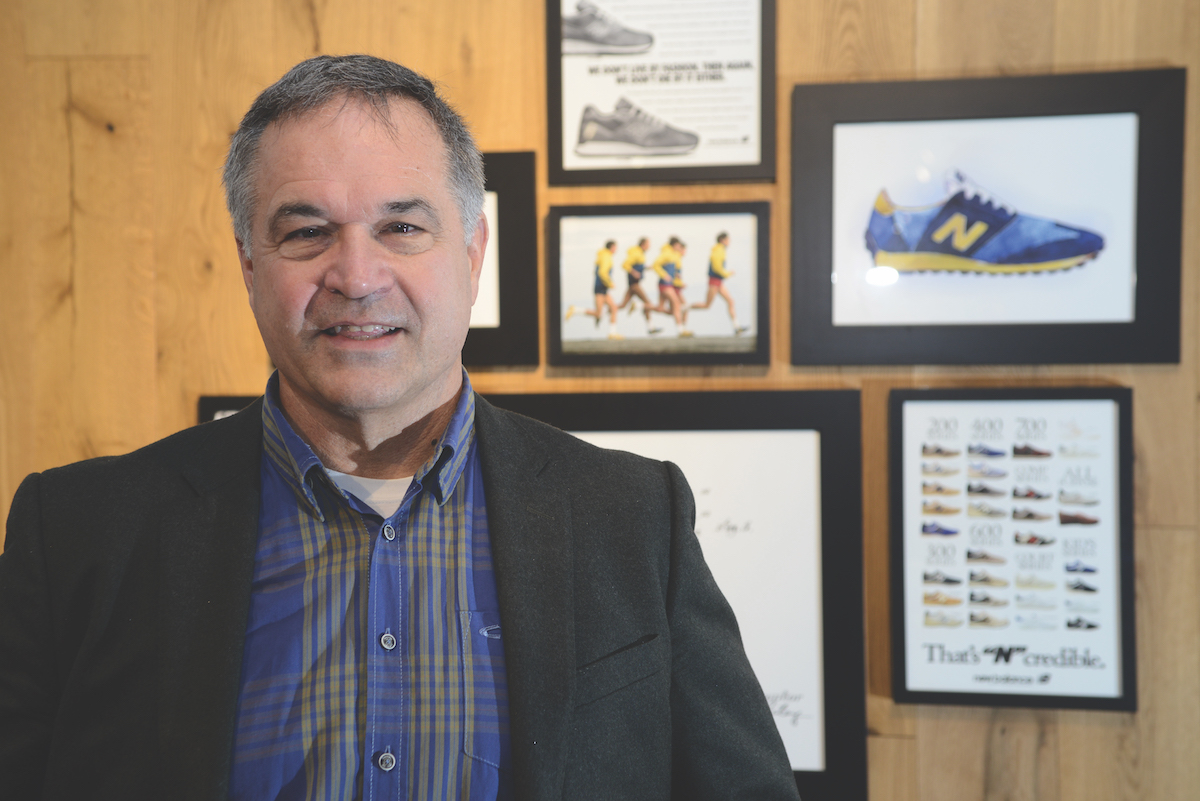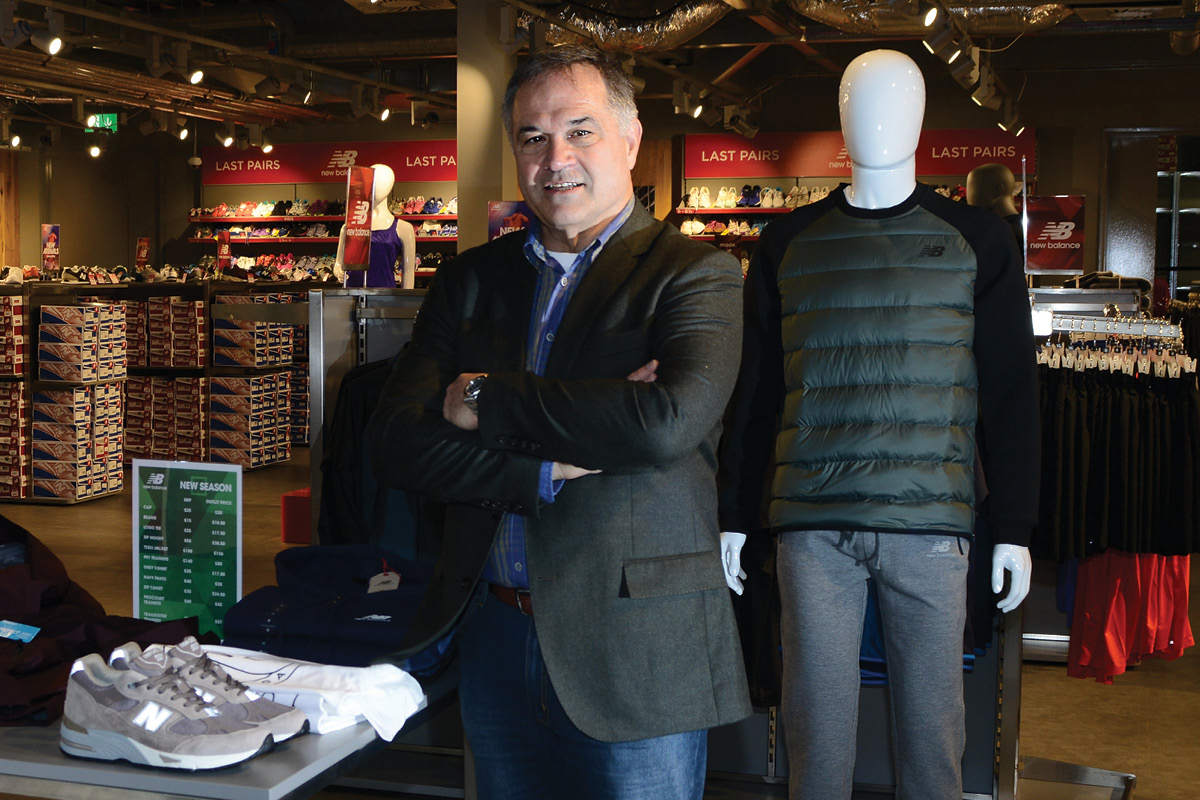Fran Allen doesn’t shy away from the fetish he developed from a very young age. In fact, the vice-president EMEA of New Balance regards his obsession as very healthy, and thrives openly on his addiction.
“It’s sports shoes,” he explains. “Yes, I think it’s safe to say I have a sports shoe fetish. I have played sport my entire life and was able to wear trainers almost every day to school and then later to university. Obviously, I have had jobs since then where you weren’t allowed to wear trainers, but I wore them every chance I could. Sports shoes are more comfortable than any other shoes I could wear and I have stuck with them.”
Fran’s passion for footwear comfort led to a career spanning more than 35 years in the sports industry, with nearly 21 of them clocked up at New Balance. Prior to his appointment to the EMEA region in 2015, he was general manager of New Balance for the UK and Ireland, and before that was responsible for the company’s American and Canadian markets.
New Balance: from arch support to sport
New Balance was founded by William Riley in 1906 in Boston, launching as an arch-support company selling to police officers and waiters. It was bought in 1972 as a six-employee team by Jim Davis, who has since transformed the company into a US$3.8-billion business, employing 5,000 people and producing shoes and sports clothing for running, football, cross-training, walking and tennis.

The brand has enjoyed an annual growth of 30% for the past 5 years in European markets.
The company’s brands include Brine, Aravon, Dunham, PF Flyers and Warrior Sports, and are often seen emblazoned as sponsors for various international teams and athletes in football, athletics, cricket, cycling and tennis. While the majority of shoes are made in Asia, the company maintains its headquarters in Boston and has 5 factories throughout the US.
A team effort
Europe has a head office based in the English town of Warrington, supported by a factory 3 hours north in Flimby. The brand has enjoyed an annual growth of 30% for the past 5 years in EMEA markets, an impressive achievement, but one which Fran refuses to take sole responsibility for.
“I inherited a great team here, and rapid growth was already starting,” he says. “Our focus is on the consumer, and we extended our ecommerce business to cater to that demand. But we are also opening up new stores across Western Europe.
“Our flagship stores in London and Milan opened in 2016, as did Amsterdam and Paris, with Berlin and Madrid opening the year before. The aim is to have 100 owned-and-operated stores, as well as 150 partner stores, across Europe by 2020.
“It’s pretty simple when you look at what we stand for in our heritage and authenticity,” he adds. “We’ve been designing, developing and manufacturing some of the finest running shoes in the world for more than 60 years. There’s also the fact that it’s a family-owned business, run by the current owners since 1972 on the core values of integrity, teamwork and total customer satisfaction.”
A signature shoe
If you want to start an argument, ask New Balance devotees which shoe is most popular. Numbers and letters, which are used to define the style and performance, will be rattled off with dogged authority and conviction, leaving no doubt of the passion, but a whole lot of confusion about which shoe is trademark. While endeavouring to be loyal to every model, Fran sticks his neck out, just a little.
“I don’t think we have a signature shoe,” he says. “It depends on who you speak to and what part of the world you’re in. But in general, the 574 is probably our signature shoe because we sell millions of pairs a year across all continents. If you look at North America, they would say their signature shoe would be the 990, a shoe developed in 1981. It has obviously undergone many, many updates over the years, and many improvements, but it’s very high performance, kind of a luxury shoe for runners.”
Fran Allen’s favourite shoe
And his personal favourite? “It’s the 576, another classic style from about 30 years ago made here in our UK factory. It fits my foot really well, is extremely comfortable, and is made in so many styles you can wear it for almost any occasion.”
Of course, if none of the styles suit, you can always use the customised shoe program, dubbed NB1, to design your own. Currently available in the US, online to the EMEA region and in the London and Milan flagship stores, the program enables fans to select their own colours and fabrics to create a personalised shoe and wait just a few weeks from design to delivery.
Fitness is a priority
With its vast reputation for sponsorship in sport, fitness is obviously a priority for New Balance, and that includes the company’s employees. Each staff member receives a new pair of trainers or running shoes every year, either custom made or selected from the dozens of styles available. Employees also have free access to a gym.
“We strongly encourage our team to work out,” Fran says. “When I get here at 6.30 in the morning, there’s already 4 or 5 people in the gym, and more at lunch or after work. It is a great asset to have on site. We also have a very supportive cycle-to-work scheme, walking and running clubs and a group that plays football after work. Fitness is a priority.” It was also a priority for Jim Davis and his wife, Anne, who launched the New Balance Foundation more than 30 years ago to support charitable organisations.
NB SparkStart: preventing childhood obesity
In 2001, the focus shifted to the prevention of childhood obesity with the couple launching the global program NB SparkStart in 2014 to inspire a lifetime of movement. “The focus is on how to prevent childhood obesity through better health and eating habits, but most importantly through movement,” Fran says.
“All regions get involved, and we donate shoes and apparel to children in need as well as funding grants to give opportunities to children to encourage and discover their spark to move. We have advocates and leaders volunteering to help get children motivated, because SparkStart believes that every child, in every corner of the world is born to move.”



